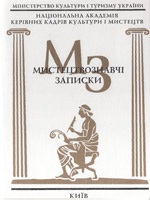Технологический аспект развития древнегреческой станковой живописи
The technological aspect of the development of the ancient greek easel painting
Author(s): Andrey Petrushevsky, Natalia PetrushevskaSubject(s): Cultural history, Visual Arts
Published by: Національна академія керівних кадрів культури і мистецтв
Keywords: Ancient Greek easel painting; encaustic; cameo; cameo glass; the silhouette drawing; limited palette; monochrome painting; layering painting; classic painting; antique impressionism;
Summary/Abstract: The purpose of the article is to clarify the stages of the art of ancient Greek easel painting. Methodology. The methodology of the study consists of the method of ordering and generalization. The authors create a periodization of ancient Greek easel painting. They also use the source study method to analyze the scientific literature on the subject of study and historicalchronological method to compare the various stages of the formation of ancient Greek easel painting. Scientific Novelty. The scientific novelty of the work lies in the analysis of the stages of technological development of ancient Greek easel painting in terms of technique of creating realistic images. Conclusions. This article has been refined the periodization of ancient Greek art, given by Pliny the Elder. For the third time, the painting is named Pliny «more clever», can be called «a period of occurrence of classical painting» or «period of layered painting», which reflects its technical nature. In the texts of «Natural History» by Pliny the Elder, dedicated to painting, we found the artist, who invented layering method of painting - Pausias of Sicyon. Based on the observations of Pliny the Elder paintings pigments disclosed the meaning of «monochrome painting», which are discussed in the literature of the history of art. Based on technological analysis of such terms as «classic (layered) painting» and «impressionistic painting» the authors have revealed the failure of the term «antique impressionism», proposed E. Keuls. Based on the historical analysis of the origin of ancient Greek painting the authors have disclosed the origin of the engraved line of drawing and inscriptions in ancient Greek and ancient Russian icon.
Journal: Мистецтвознавчі записки
- Issue Year: 2017
- Issue No: 31
- Page Range: 209-217
- Page Count: 9
- Language: Ukrainian

